Executive Summary
Despite challenges presented by the global financial crisis and economic downturn, this past year was one of continuity, with few significant shifts in the regulatory environment for PE/VC within the majority of the twelve countries in the 2009 edition of the Annual Scorecard on the Private Equity and Venture Capital Environment in Latin America and the Caribbean.
In the 2008 Scorecard edition, eleven countries registered improvements, including some significant advances. In 2009, by contrast, seven of the twelve countries experienced declines in their overall score. Score revisions this year largely reflect changes in the indicators related to the broader national operating environment: capital markets development, intellectual property protection, strength of the judicial system and perception of corruption. In addition, there was a revision of the data underlying the calculation of the entrepreneurship scoring for many countries in the region, which contributed to a general decline in scores on this indicator.
For the countries registering score changes, two – Colombia and Peru – registered an improved score in 2009. Both Colombia and Peru represent incipient new markets for private equity and venture capital investment, and specific regulations and programs were approved in 2008 to foster the development of domestic private capital funds industries.
The most significant advances in regulation for PE/VC in Colombia and Peru in recent years can be found in the rules governing local pension funds’ commitments to alternative investments. Both countries have followed Brazil’s lead in cultivating domestic sources of institutional capital for private capital firms, and a number of new funds have been raised with commitments from the Colombian and Peruvian pension funds.
In December 2008 Peru’s Banking and Insurance Superintendency approved what could be viewed as the most advanced regulation in the region in this area, allowing the country’s four private pension funds to diversify their private equity portfolios to international asset management firms. At the other end of the spectrum, Argentina stands out for having re-nationalised its pension fund system, removing any expectation that private pension funds will be a source for PE/VC fundraising.
Four countries —Chile, Uruguay, Panama and Trinidad and Tobago —experienced modest declines, by 2 points on a scale of 100 possible. Yet in three countries with relatively low scores, larger and more pronounced drops of four points (Argentina and El Salvador) or six points (the Dominican Republic) were manifest. Three countries held their scores constant – Brazil, Mexico and Costa Rica.
The single biggest factor in declines in country scores appears to have been—at least indirectly—the global economic slowdown, through its impact on local capital markets. While Latin America has demonstrated that its hard-won macroeconomic reforms have cushioned it from some of the worst immediate effects of the global recession, the crisis in financial markets did appear to have a generally negative impact on scores for capital market development and the feasibility of initial public offerings. Stock market valuations and liquidity declined dramatically in fall 2008. Even in the minority of countries which have the necessary scale of investment, listing procedures, and other conditions for successful IPO exits, informants report that in the near term such exits are next to impossible.
In nearly half of the countries covered by the Scorecard (Colombia, the Dominican Republic, El Salvador, Panama, Trinidad and Tobago, and Uruguay), the Economist Intelligence Unit assigned lower scores for capital market development than those in last year’s edition. Entrepreneurship scores for the region were in many cases revised downwards due to an improved dataset from the World Bank which clarified the key metric of entrepreneurship, the entry rate. An increased number of electronic registration offices has led to the provision of more accurate information. This has, in turn, led to a downward revision in the total number of registered businesses in almost all Latin American countries, and subsequently, a revised calculation of the new business entry rate.
There is no other singular common thread among the seven nations with lower scores in 2009, if we examine their scores disaggregated by indicator. However, in two instances (El Salvador, and Uruguay) there were also deteriorations in the ratings of the strength of the judicial system.
The degree to which the business environment is friendly or not to venture capital and private equity investment continues to vary sharply across the LAC region. At the business friendly end of the spectrum, Chile ranks 76 on a scale of 1-100 (with 100 being the most investment friendly) and surpasses the next four most highly rated countries—Brazil at 75, Trinidad and Tobago at 63, Mexico at 58 and Colombia at 57.
Colombia made the single biggest advance, moving four points up from a score of 53 and from a former ranking of 6th (out of 13 countries) to its present 5th (out of 12). This was thanks to improvements in its protection of minority rights, corporate governance, and freedoms for institutional investment in PE/VC activities, as capital market and corporate governance reforms adopted in previous years began to bear fruit and take form; these gains outweighed a lower score for capital market development.
Rounding out the top six countries was Uruguay at 54. Of the 12 countries, eight score a 50 or above (compared to 10 out of 13 in 2008).
Usefully, the scorecard continues to benchmark the LAC countries by comparing them with four countries outside the region. These “comparator” countries—such as the UK—are known for their more robust PE/VC industries but some also for their relatively recent emergence as developed countries—Israel, Spain and Taiwan. All of the LAC countries, even Chile (76), lag behind the highly favourable PE/VC business climate of the UK (90), Israel (81), and Spain. Only Chile, Brazil, and Trinidad and Tobago rank ahead of or equal to Taiwan (63).
LAVCA and the Economist Intelligence Unit made two important changes in this year’s scorecard. First, Ecuador was not included in this year’s study, due to the apparent lack of private capital activity in that country. Second, a new World Bank entrepreneurship database was available to clarify the new business entry rate. This provided a more precise calculation of entrepreneurship scores, and consequently some downward revisions. While many organizations are moving to develop a more detailed understanding of the components of entrepreneurship for regions and countries worldwide, the World Bank data remains the best source of information for Latin America, and provides the most useful standard metric for this indicator.
The full list of scoring criteria is:
- Laws on VC/PE fund formation and operation
- Tax treatment of VC/PE funds and investments
- Protection of minority shareholder rights
- Restrictions on institutional investors in making VC/PE investments
- Protection of intellectual property rights
- Bankruptcy regulation (encompassing bankruptcy procedures/creditor rights/partner liability in cases of bankruptcy)
- Capital market development and feasibility of local exits (ie, initial public offerings)
- Registration/reserve requirements on inward investments
- Corporate governance requirements
- Strength of the judicial system
- Perceived corruption
- Use of international accounting standards and quality of the local accounting industry
- Entrepreneurship


